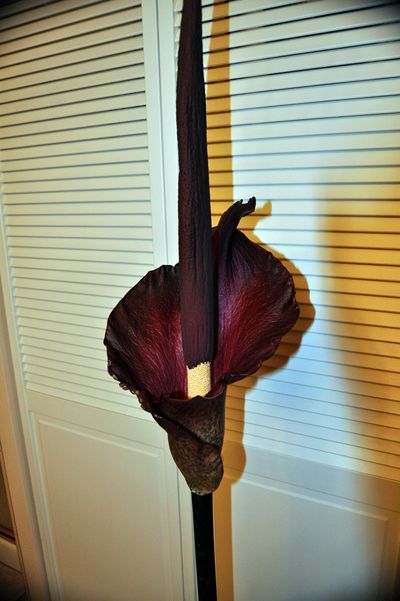Odiferous, mysterious lily blooms in basement

Botanical mysteries are the norm during the growing season. But in the dead of winter, they can go a long way to liven up the dreary days.
In this case, it all started when Ed Baltutat called to say he had a mystery growing in his basement.
His wife, Laurie, had made a trip into the basement laundry room of their Spokane Valley home and to her surprise, one of their overwintering potted plants was sending up a large spike from a seemingly dried-up bulb. Over the next few days the mottled cream and green spike grew to a height of 3 feet and began unfurling a large dark red “leaf” and a 3-foot, equally dark red spike that grew an additional three feet.
By this time, Ed was researching online trying to figure out what it was. Several possibilities emerged and one disturbing fact needed to be verified quickly. The research was indicating that the plant would soon become rather odoriferous, as in dead-animal stinky. That’s when Ed called me to find out where they could put the plant until it finished blooming. Given it wouldn’t survive outdoors and they weren’t going to open the windows in the dead of winter, this was a dilemma.
Ed’s research identified the plant tentatively as a voodoo lily or Amorphophallus konjac, native to Asia. It’s also known as devil’s tongue, dragon plant, elephant yam, konnyku, leopard arum, snake palm and umbrella arum.
The tall flower stalk produces a ruffled leaf called a spathe that frames a tall fleshy spadix. The female part of the flower is at the base of the spadix while the male pollen bearing area is at the top of the spadix. Here’s where the stinky scent comes in; the plant needs to attract carrion flies to pollinate the female flowers. The flies think they found a meal and, while they are wandering around on the spadix trying to find it, they pollinate the flowers.
Voodoo lilies are a member of the philodendron family and grow from a large, edible tuber. The tuber, which can grow to several pounds, is used to make konjac flour or a stiff jelly made from its starch. The Japanese use the flour to make shirataki noodles, and the jelly is used to make a popular Asian fruit jelly snack. It is also a vegan substitute for gelatin. During the growing season, the plant sends out a single large leaf that can be an interesting conversation piece.
The Baltutarts chose to keep the plant in their downstairs bathroom with the fan on and a towel tucked along the bottom of the door. When I stopped by to see it, the odor was only noticeable once you got into the bathroom and even then it wasn’t too bad. In fact according to Ed, their two dogs have breath that is much worse. “To be fair to the dogs, we don’t leave the bath fan on 24/7 to mitigate the dogs’ breath,” he said.